CHCDEV002: Analyse Sociological Factors in Community Work Assessment
VerifiedAdded on 2020/07/22
|22
|8084
|883
Homework Assignment
AI Summary
This assessment book for CHCDEV002 explores the impacts of sociological factors on clients within community work and services. The assignment delves into key concepts such as case management, defining and understanding social and cultural institutions in Australian society, and the effects of inequality on individuals and society. It also covers the understanding of stereotypes, their development, and their impact on clients, particularly in low socioeconomic areas. The assessment requires students to demonstrate their knowledge through various tasks, including defining terms, completing tables, selecting true or false statements, and providing brief explanations and examples. The assessment emphasizes the importance of understanding sociological factors in providing effective community services and avoiding plagiarism.
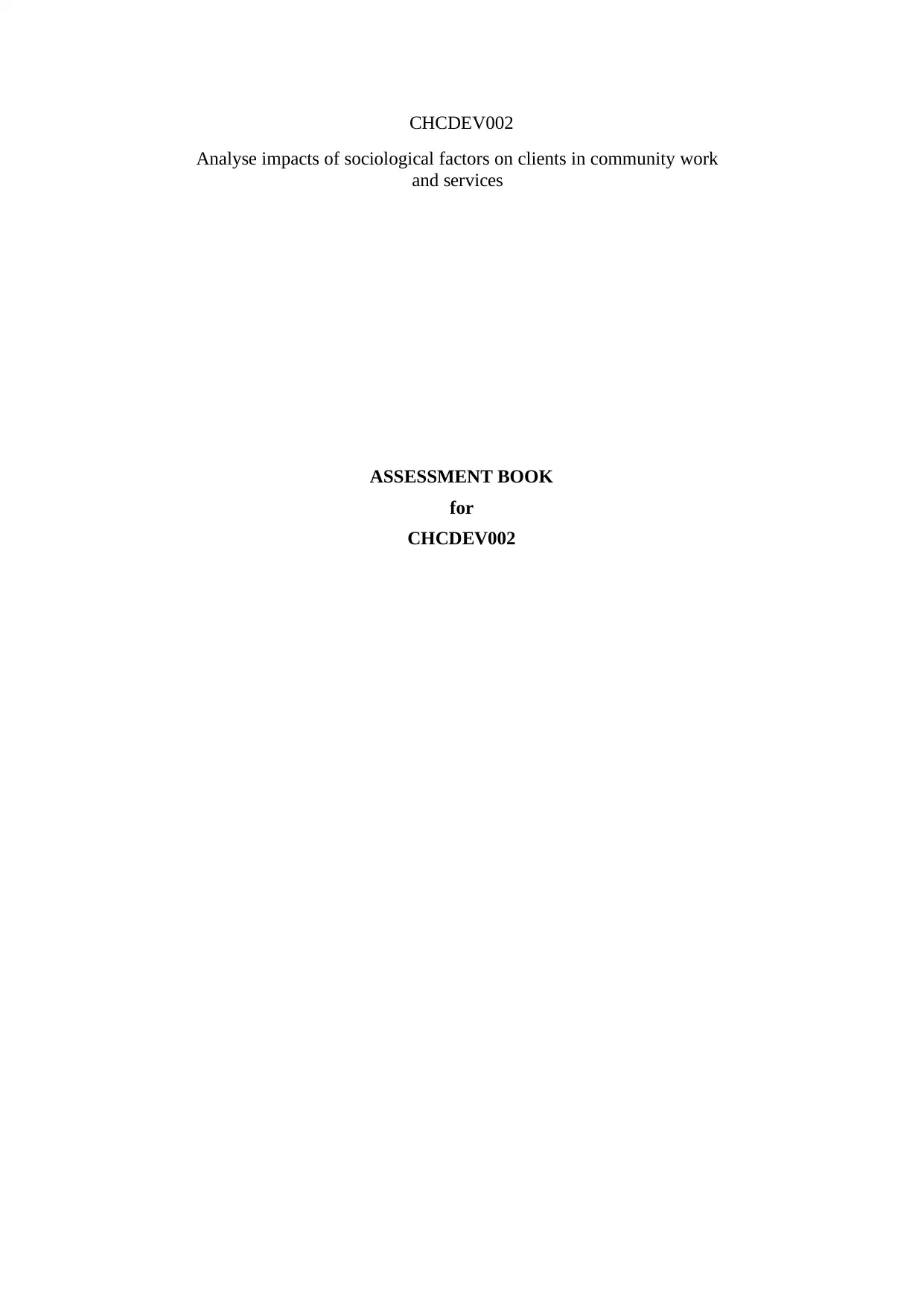
CHCDEV002
Analyse impacts of sociological factors on clients in community work
and services
ASSESSMENT BOOK
for
CHCDEV002
Analyse impacts of sociological factors on clients in community work
and services
ASSESSMENT BOOK
for
CHCDEV002
Paraphrase This Document
Need a fresh take? Get an instant paraphrase of this document with our AI Paraphraser

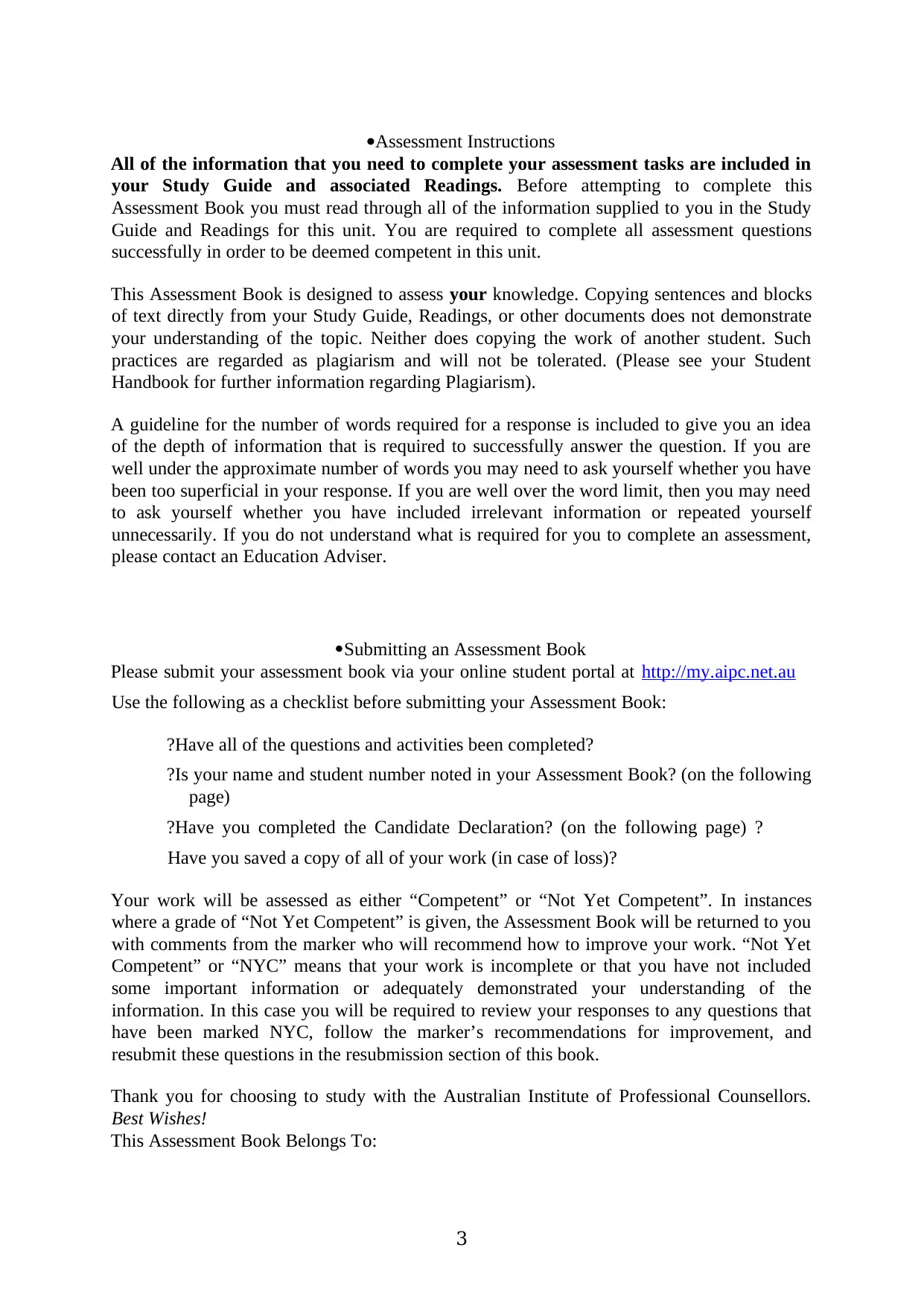
·Assessment Instructions
All of the information that you need to complete your assessment tasks are included in
your Study Guide and associated Readings. Before attempting to complete this
Assessment Book you must read through all of the information supplied to you in the Study
Guide and Readings for this unit. You are required to complete all assessment questions
successfully in order to be deemed competent in this unit.
This Assessment Book is designed to assess your knowledge. Copying sentences and blocks
of text directly from your Study Guide, Readings, or other documents does not demonstrate
your understanding of the topic. Neither does copying the work of another student. Such
practices are regarded as plagiarism and will not be tolerated. (Please see your Student
Handbook for further information regarding Plagiarism).
A guideline for the number of words required for a response is included to give you an idea
of the depth of information that is required to successfully answer the question. If you are
well under the approximate number of words you may need to ask yourself whether you have
been too superficial in your response. If you are well over the word limit, then you may need
to ask yourself whether you have included irrelevant information or repeated yourself
unnecessarily. If you do not understand what is required for you to complete an assessment,
please contact an Education Adviser.
·Submitting an Assessment Book
Please submit your assessment book via your online student portal at http://my.aipc.net.au
Use the following as a checklist before submitting your Assessment Book:
?Have all of the questions and activities been completed?
?Is your name and student number noted in your Assessment Book? (on the following
page)
?Have you completed the Candidate Declaration? (on the following page) ?
Have you saved a copy of all of your work (in case of loss)?
Your work will be assessed as either “Competent” or “Not Yet Competent”. In instances
where a grade of “Not Yet Competent” is given, the Assessment Book will be returned to you
with comments from the marker who will recommend how to improve your work. “Not Yet
Competent” or “NYC” means that your work is incomplete or that you have not included
some important information or adequately demonstrated your understanding of the
information. In this case you will be required to review your responses to any questions that
have been marked NYC, follow the marker’s recommendations for improvement, and
resubmit these questions in the resubmission section of this book.
Thank you for choosing to study with the Australian Institute of Professional Counsellors.
Best Wishes!
This Assessment Book Belongs To:
3
All of the information that you need to complete your assessment tasks are included in
your Study Guide and associated Readings. Before attempting to complete this
Assessment Book you must read through all of the information supplied to you in the Study
Guide and Readings for this unit. You are required to complete all assessment questions
successfully in order to be deemed competent in this unit.
This Assessment Book is designed to assess your knowledge. Copying sentences and blocks
of text directly from your Study Guide, Readings, or other documents does not demonstrate
your understanding of the topic. Neither does copying the work of another student. Such
practices are regarded as plagiarism and will not be tolerated. (Please see your Student
Handbook for further information regarding Plagiarism).
A guideline for the number of words required for a response is included to give you an idea
of the depth of information that is required to successfully answer the question. If you are
well under the approximate number of words you may need to ask yourself whether you have
been too superficial in your response. If you are well over the word limit, then you may need
to ask yourself whether you have included irrelevant information or repeated yourself
unnecessarily. If you do not understand what is required for you to complete an assessment,
please contact an Education Adviser.
·Submitting an Assessment Book
Please submit your assessment book via your online student portal at http://my.aipc.net.au
Use the following as a checklist before submitting your Assessment Book:
?Have all of the questions and activities been completed?
?Is your name and student number noted in your Assessment Book? (on the following
page)
?Have you completed the Candidate Declaration? (on the following page) ?
Have you saved a copy of all of your work (in case of loss)?
Your work will be assessed as either “Competent” or “Not Yet Competent”. In instances
where a grade of “Not Yet Competent” is given, the Assessment Book will be returned to you
with comments from the marker who will recommend how to improve your work. “Not Yet
Competent” or “NYC” means that your work is incomplete or that you have not included
some important information or adequately demonstrated your understanding of the
information. In this case you will be required to review your responses to any questions that
have been marked NYC, follow the marker’s recommendations for improvement, and
resubmit these questions in the resubmission section of this book.
Thank you for choosing to study with the Australian Institute of Professional Counsellors.
Best Wishes!
This Assessment Book Belongs To:
3
⊘ This is a preview!⊘
Do you want full access?
Subscribe today to unlock all pages.

Trusted by 1+ million students worldwide
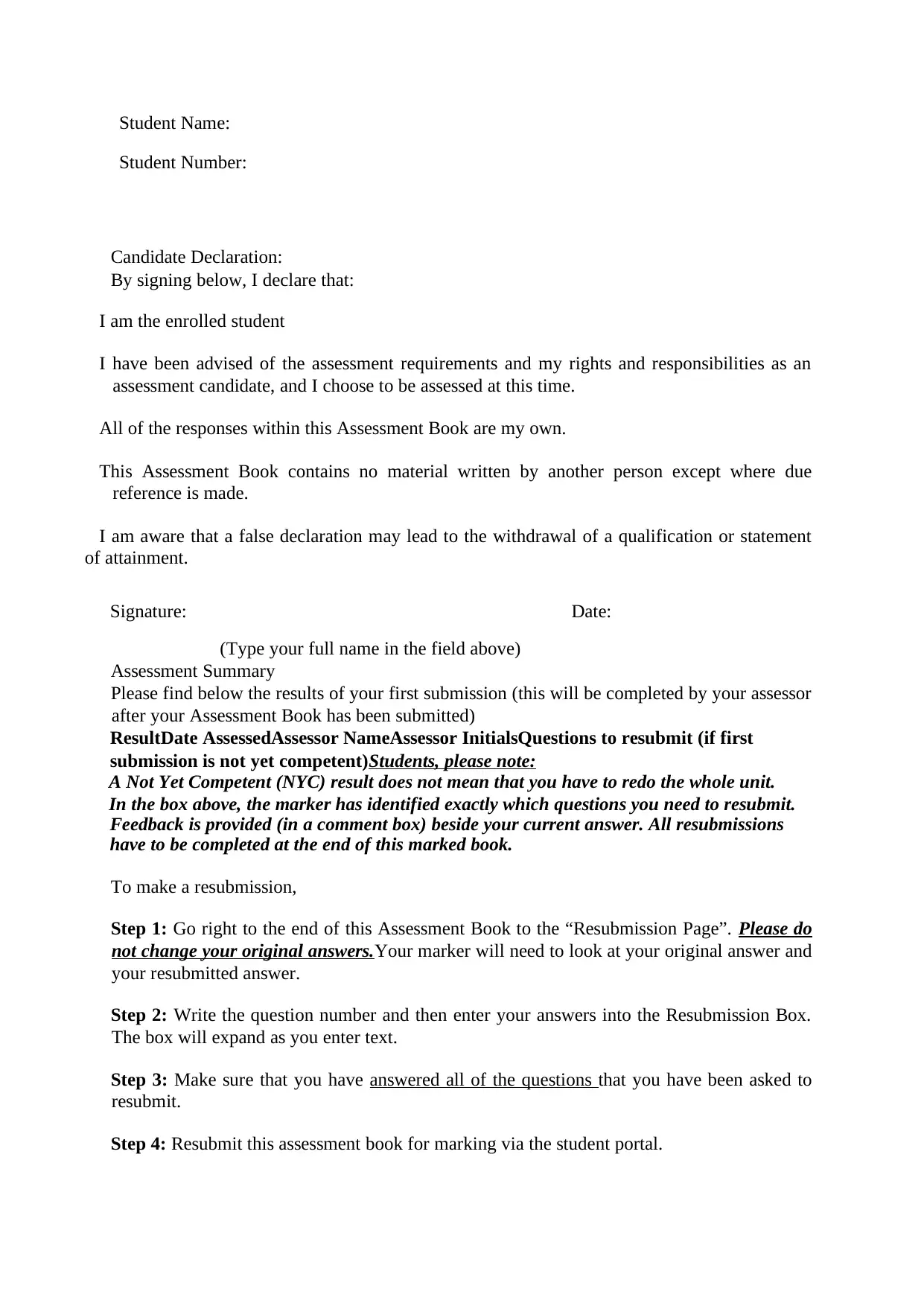
Student Name:
Student Number:
Candidate Declaration:
By signing below, I declare that:
壱I am the enrolled student
壱I have been advised of the assessment requirements and my rights and responsibilities as an
assessment candidate, and I choose to be assessed at this time.
壱All of the responses within this Assessment Book are my own.
壱This Assessment Book contains no material written by another person except where due
reference is made.
壱I am aware that a false declaration may lead to the withdrawal of a qualification or statement
of attainment.
Signature: Date:
(Type your full name in the field above)
Assessment Summary
Please find below the results of your first submission (this will be completed by your assessor
after your Assessment Book has been submitted)
ResultDate AssessedAssessor NameAssessor InitialsQuestions to resubmit (if first
submission is not yet competent)Students, please note:
A Not Yet Competent (NYC) result does not mean that you have to redo the whole unit.
In the box above, the marker has identified exactly which questions you need to resubmit.
Feedback is provided (in a comment box) beside your current answer. All resubmissions
have to be completed at the end of this marked book.
To make a resubmission,
Step 1: Go right to the end of this Assessment Book to the “Resubmission Page”. Please do
not change your original answers.Your marker will need to look at your original answer and
your resubmitted answer.
Step 2: Write the question number and then enter your answers into the Resubmission Box.
The box will expand as you enter text.
Step 3: Make sure that you have answered all of the questions that you have been asked to
resubmit.
Step 4: Resubmit this assessment book for marking via the student portal.
Student Number:
Candidate Declaration:
By signing below, I declare that:
壱I am the enrolled student
壱I have been advised of the assessment requirements and my rights and responsibilities as an
assessment candidate, and I choose to be assessed at this time.
壱All of the responses within this Assessment Book are my own.
壱This Assessment Book contains no material written by another person except where due
reference is made.
壱I am aware that a false declaration may lead to the withdrawal of a qualification or statement
of attainment.
Signature: Date:
(Type your full name in the field above)
Assessment Summary
Please find below the results of your first submission (this will be completed by your assessor
after your Assessment Book has been submitted)
ResultDate AssessedAssessor NameAssessor InitialsQuestions to resubmit (if first
submission is not yet competent)Students, please note:
A Not Yet Competent (NYC) result does not mean that you have to redo the whole unit.
In the box above, the marker has identified exactly which questions you need to resubmit.
Feedback is provided (in a comment box) beside your current answer. All resubmissions
have to be completed at the end of this marked book.
To make a resubmission,
Step 1: Go right to the end of this Assessment Book to the “Resubmission Page”. Please do
not change your original answers.Your marker will need to look at your original answer and
your resubmitted answer.
Step 2: Write the question number and then enter your answers into the Resubmission Box.
The box will expand as you enter text.
Step 3: Make sure that you have answered all of the questions that you have been asked to
resubmit.
Step 4: Resubmit this assessment book for marking via the student portal.
Paraphrase This Document
Need a fresh take? Get an instant paraphrase of this document with our AI Paraphraser
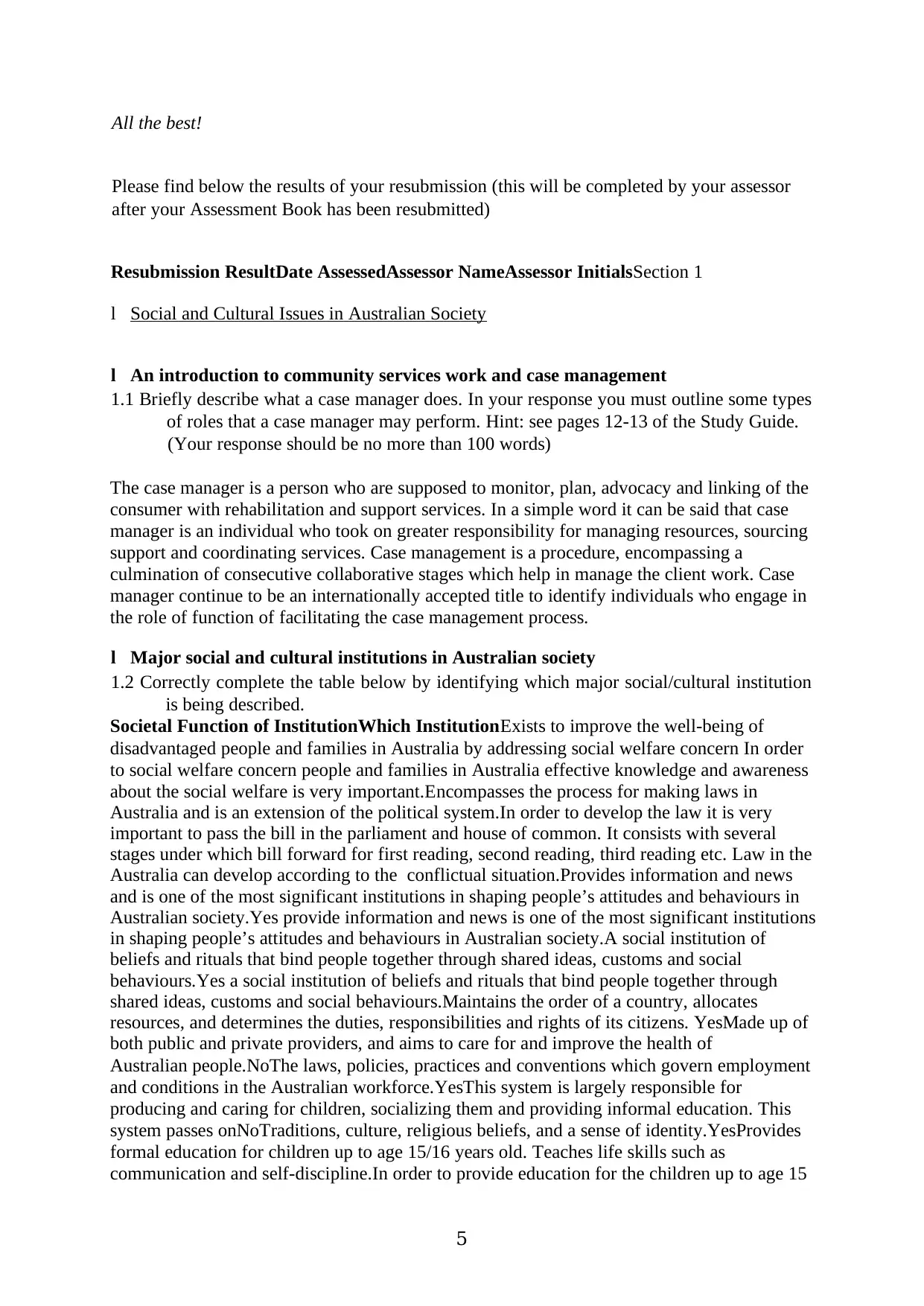
All the best!
Please find below the results of your resubmission (this will be completed by your assessor
after your Assessment Book has been resubmitted)
Resubmission ResultDate AssessedAssessor NameAssessor InitialsSection 1
l壱Social and Cultural Issues in Australian Society
l弐An introduction to community services work and case management
1.1 Briefly describe what a case manager does. In your response you must outline some types
of roles that a case manager may perform. Hint: see pages 12-13 of the Study Guide.
(Your response should be no more than 100 words)
The case manager is a person who are supposed to monitor, plan, advocacy and linking of the
consumer with rehabilitation and support services. In a simple word it can be said that case
manager is an individual who took on greater responsibility for managing resources, sourcing
support and coordinating services. Case management is a procedure, encompassing a
culmination of consecutive collaborative stages which help in manage the client work. Case
manager continue to be an internationally accepted title to identify individuals who engage in
the role of function of facilitating the case management process.
l弐Major social and cultural institutions in Australian society
1.2 Correctly complete the table below by identifying which major social/cultural institution
is being described.
Societal Function of InstitutionWhich InstitutionExists to improve the well-being of
disadvantaged people and families in Australia by addressing social welfare concern In order
to social welfare concern people and families in Australia effective knowledge and awareness
about the social welfare is very important.Encompasses the process for making laws in
Australia and is an extension of the political system.In order to develop the law it is very
important to pass the bill in the parliament and house of common. It consists with several
stages under which bill forward for first reading, second reading, third reading etc. Law in the
Australia can develop according to the conflictual situation.Provides information and news
and is one of the most significant institutions in shaping people’s attitudes and behaviours in
Australian society.Yes provide information and news is one of the most significant institutions
in shaping people’s attitudes and behaviours in Australian society.A social institution of
beliefs and rituals that bind people together through shared ideas, customs and social
behaviours.Yes a social institution of beliefs and rituals that bind people together through
shared ideas, customs and social behaviours.Maintains the order of a country, allocates
resources, and determines the duties, responsibilities and rights of its citizens. YesMade up of
both public and private providers, and aims to care for and improve the health of
Australian people.NoThe laws, policies, practices and conventions which govern employment
and conditions in the Australian workforce.YesThis system is largely responsible for
producing and caring for children, socializing them and providing informal education. This
system passes onNoTraditions, culture, religious beliefs, and a sense of identity.YesProvides
formal education for children up to age 15/16 years old. Teaches life skills such as
communication and self-discipline.In order to provide education for the children up to age 15
5
Please find below the results of your resubmission (this will be completed by your assessor
after your Assessment Book has been resubmitted)
Resubmission ResultDate AssessedAssessor NameAssessor InitialsSection 1
l壱Social and Cultural Issues in Australian Society
l弐An introduction to community services work and case management
1.1 Briefly describe what a case manager does. In your response you must outline some types
of roles that a case manager may perform. Hint: see pages 12-13 of the Study Guide.
(Your response should be no more than 100 words)
The case manager is a person who are supposed to monitor, plan, advocacy and linking of the
consumer with rehabilitation and support services. In a simple word it can be said that case
manager is an individual who took on greater responsibility for managing resources, sourcing
support and coordinating services. Case management is a procedure, encompassing a
culmination of consecutive collaborative stages which help in manage the client work. Case
manager continue to be an internationally accepted title to identify individuals who engage in
the role of function of facilitating the case management process.
l弐Major social and cultural institutions in Australian society
1.2 Correctly complete the table below by identifying which major social/cultural institution
is being described.
Societal Function of InstitutionWhich InstitutionExists to improve the well-being of
disadvantaged people and families in Australia by addressing social welfare concern In order
to social welfare concern people and families in Australia effective knowledge and awareness
about the social welfare is very important.Encompasses the process for making laws in
Australia and is an extension of the political system.In order to develop the law it is very
important to pass the bill in the parliament and house of common. It consists with several
stages under which bill forward for first reading, second reading, third reading etc. Law in the
Australia can develop according to the conflictual situation.Provides information and news
and is one of the most significant institutions in shaping people’s attitudes and behaviours in
Australian society.Yes provide information and news is one of the most significant institutions
in shaping people’s attitudes and behaviours in Australian society.A social institution of
beliefs and rituals that bind people together through shared ideas, customs and social
behaviours.Yes a social institution of beliefs and rituals that bind people together through
shared ideas, customs and social behaviours.Maintains the order of a country, allocates
resources, and determines the duties, responsibilities and rights of its citizens. YesMade up of
both public and private providers, and aims to care for and improve the health of
Australian people.NoThe laws, policies, practices and conventions which govern employment
and conditions in the Australian workforce.YesThis system is largely responsible for
producing and caring for children, socializing them and providing informal education. This
system passes onNoTraditions, culture, religious beliefs, and a sense of identity.YesProvides
formal education for children up to age 15/16 years old. Teaches life skills such as
communication and self-discipline.In order to provide education for the children up to age 15
5
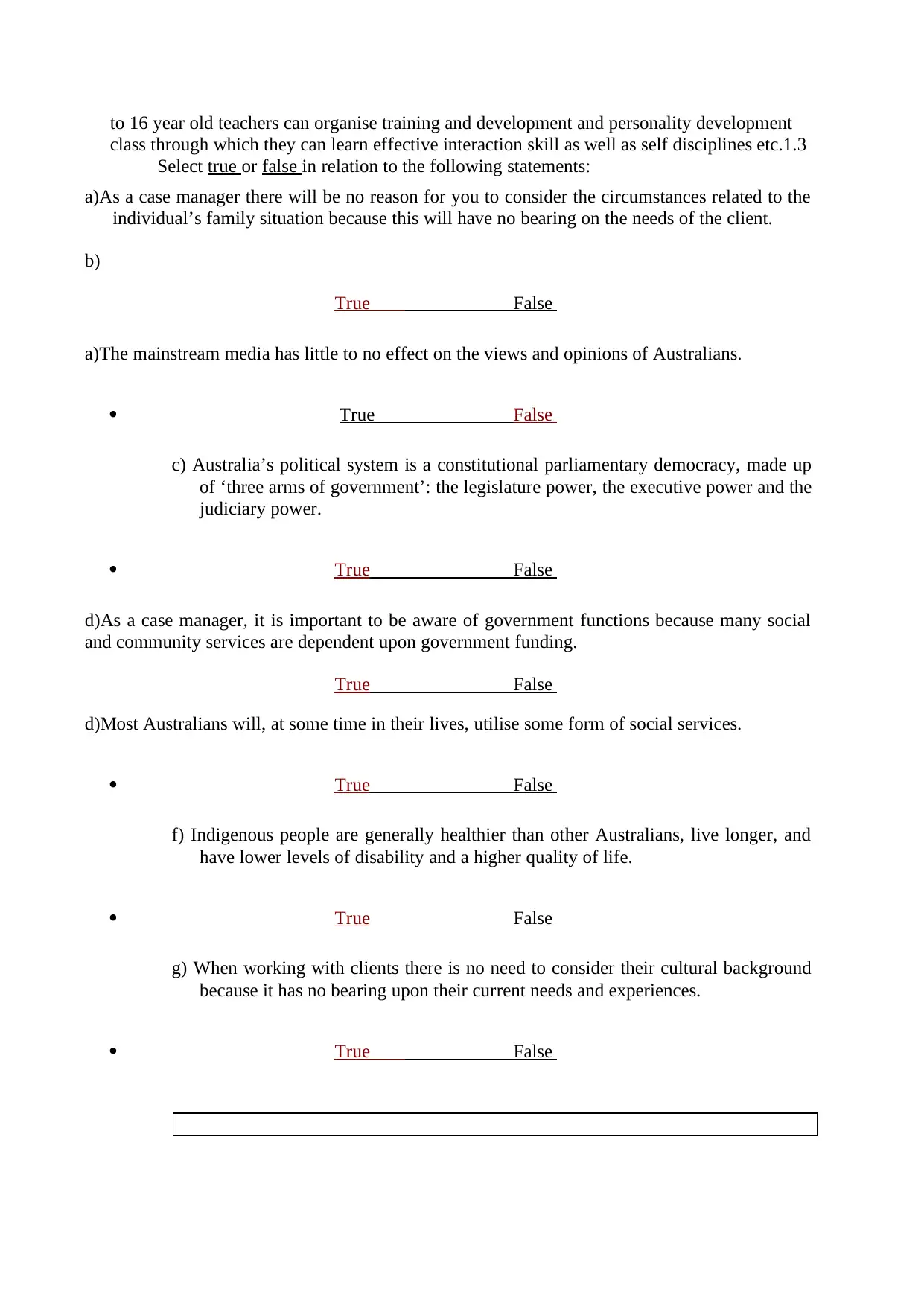
to 16 year old teachers can organise training and development and personality development
class through which they can learn effective interaction skill as well as self disciplines etc.1.3
Select true or false in relation to the following statements:
a)As a case manager there will be no reason for you to consider the circumstances related to the
individual’s family situation because this will have no bearing on the needs of the client.
b)
True False
a)The mainstream media has little to no effect on the views and opinions of Australians.
· True False
c) Australia’s political system is a constitutional parliamentary democracy, made up
of ‘three arms of government’: the legislature power, the executive power and the
judiciary power.
· True False
d)As a case manager, it is important to be aware of government functions because many social
and community services are dependent upon government funding.
True False
d)Most Australians will, at some time in their lives, utilise some form of social services.
· True False
f) Indigenous people are generally healthier than other Australians, live longer, and
have lower levels of disability and a higher quality of life.
· True False
g) When working with clients there is no need to consider their cultural background
because it has no bearing upon their current needs and experiences.
· True False
class through which they can learn effective interaction skill as well as self disciplines etc.1.3
Select true or false in relation to the following statements:
a)As a case manager there will be no reason for you to consider the circumstances related to the
individual’s family situation because this will have no bearing on the needs of the client.
b)
True False
a)The mainstream media has little to no effect on the views and opinions of Australians.
· True False
c) Australia’s political system is a constitutional parliamentary democracy, made up
of ‘three arms of government’: the legislature power, the executive power and the
judiciary power.
· True False
d)As a case manager, it is important to be aware of government functions because many social
and community services are dependent upon government funding.
True False
d)Most Australians will, at some time in their lives, utilise some form of social services.
· True False
f) Indigenous people are generally healthier than other Australians, live longer, and
have lower levels of disability and a higher quality of life.
· True False
g) When working with clients there is no need to consider their cultural background
because it has no bearing upon their current needs and experiences.
· True False
⊘ This is a preview!⊘
Do you want full access?
Subscribe today to unlock all pages.

Trusted by 1+ million students worldwide
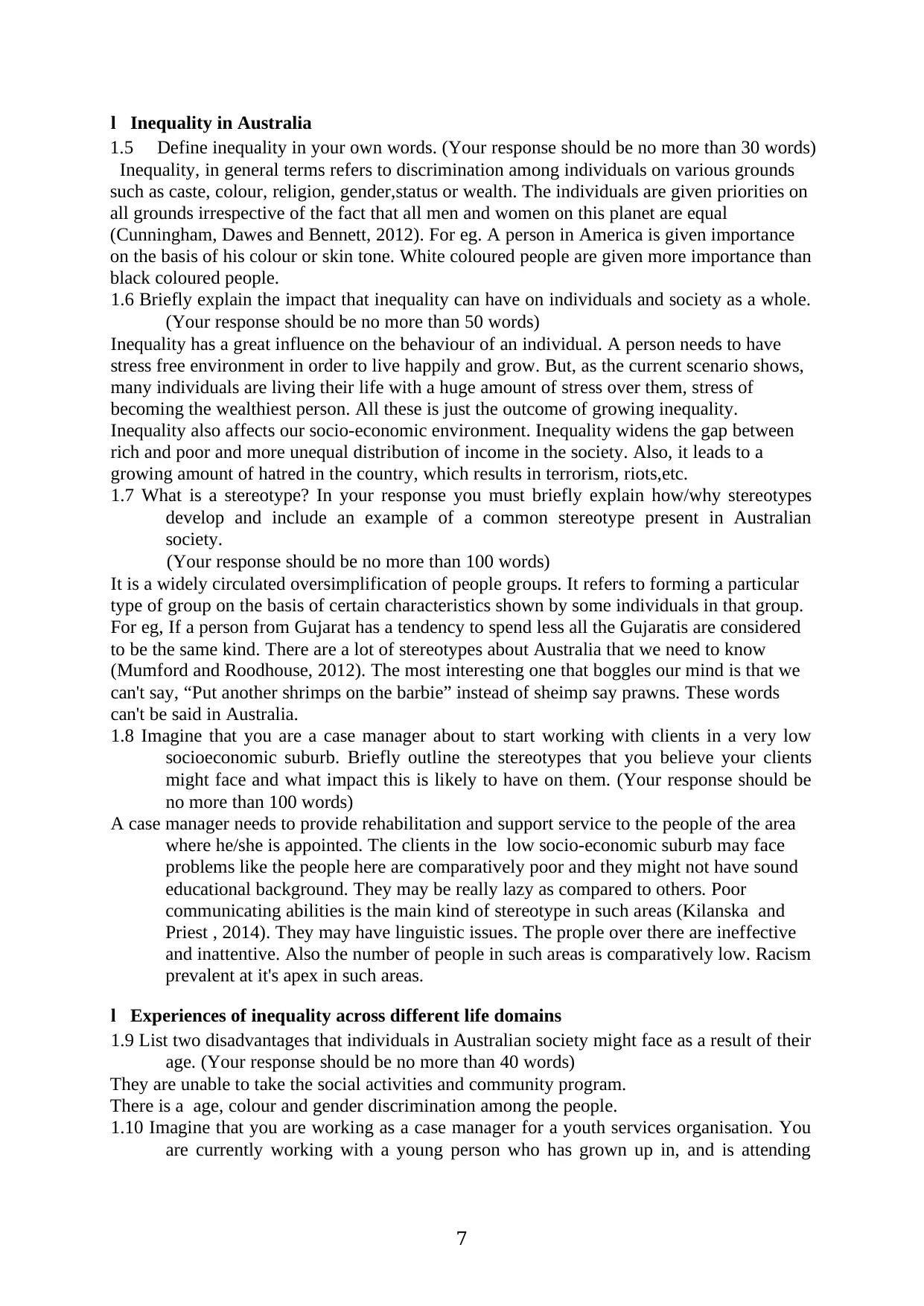
l弐Inequality in Australia
1.5 Define inequality in your own words. (Your response should be no more than 30 words)
Inequality, in general terms refers to discrimination among individuals on various grounds
such as caste, colour, religion, gender,status or wealth. The individuals are given priorities on
all grounds irrespective of the fact that all men and women on this planet are equal
(Cunningham, Dawes and Bennett, 2012). For eg. A person in America is given importance
on the basis of his colour or skin tone. White coloured people are given more importance than
black coloured people.
1.6 Briefly explain the impact that inequality can have on individuals and society as a whole.
(Your response should be no more than 50 words)
Inequality has a great influence on the behaviour of an individual. A person needs to have
stress free environment in order to live happily and grow. But, as the current scenario shows,
many individuals are living their life with a huge amount of stress over them, stress of
becoming the wealthiest person. All these is just the outcome of growing inequality.
Inequality also affects our socio-economic environment. Inequality widens the gap between
rich and poor and more unequal distribution of income in the society. Also, it leads to a
growing amount of hatred in the country, which results in terrorism, riots,etc.
1.7 What is a stereotype? In your response you must briefly explain how/why stereotypes
develop and include an example of a common stereotype present in Australian
society.
(Your response should be no more than 100 words)
It is a widely circulated oversimplification of people groups. It refers to forming a particular
type of group on the basis of certain characteristics shown by some individuals in that group.
For eg, If a person from Gujarat has a tendency to spend less all the Gujaratis are considered
to be the same kind. There are a lot of stereotypes about Australia that we need to know
(Mumford and Roodhouse, 2012). The most interesting one that boggles our mind is that we
can't say, “Put another shrimps on the barbie” instead of sheimp say prawns. These words
can't be said in Australia.
1.8 Imagine that you are a case manager about to start working with clients in a very low
socioeconomic suburb. Briefly outline the stereotypes that you believe your clients
might face and what impact this is likely to have on them. (Your response should be
no more than 100 words)
A case manager needs to provide rehabilitation and support service to the people of the area
where he/she is appointed. The clients in the low socio-economic suburb may face
problems like the people here are comparatively poor and they might not have sound
educational background. They may be really lazy as compared to others. Poor
communicating abilities is the main kind of stereotype in such areas (Kilanska and
Priest , 2014). They may have linguistic issues. The prople over there are ineffective
and inattentive. Also the number of people in such areas is comparatively low. Racism
prevalent at it's apex in such areas.
l弐Experiences of inequality across different life domains
1.9 List two disadvantages that individuals in Australian society might face as a result of their
age. (Your response should be no more than 40 words)
They are unable to take the social activities and community program.
There is a age, colour and gender discrimination among the people.
1.10 Imagine that you are working as a case manager for a youth services organisation. You
are currently working with a young person who has grown up in, and is attending
7
1.5 Define inequality in your own words. (Your response should be no more than 30 words)
Inequality, in general terms refers to discrimination among individuals on various grounds
such as caste, colour, religion, gender,status or wealth. The individuals are given priorities on
all grounds irrespective of the fact that all men and women on this planet are equal
(Cunningham, Dawes and Bennett, 2012). For eg. A person in America is given importance
on the basis of his colour or skin tone. White coloured people are given more importance than
black coloured people.
1.6 Briefly explain the impact that inequality can have on individuals and society as a whole.
(Your response should be no more than 50 words)
Inequality has a great influence on the behaviour of an individual. A person needs to have
stress free environment in order to live happily and grow. But, as the current scenario shows,
many individuals are living their life with a huge amount of stress over them, stress of
becoming the wealthiest person. All these is just the outcome of growing inequality.
Inequality also affects our socio-economic environment. Inequality widens the gap between
rich and poor and more unequal distribution of income in the society. Also, it leads to a
growing amount of hatred in the country, which results in terrorism, riots,etc.
1.7 What is a stereotype? In your response you must briefly explain how/why stereotypes
develop and include an example of a common stereotype present in Australian
society.
(Your response should be no more than 100 words)
It is a widely circulated oversimplification of people groups. It refers to forming a particular
type of group on the basis of certain characteristics shown by some individuals in that group.
For eg, If a person from Gujarat has a tendency to spend less all the Gujaratis are considered
to be the same kind. There are a lot of stereotypes about Australia that we need to know
(Mumford and Roodhouse, 2012). The most interesting one that boggles our mind is that we
can't say, “Put another shrimps on the barbie” instead of sheimp say prawns. These words
can't be said in Australia.
1.8 Imagine that you are a case manager about to start working with clients in a very low
socioeconomic suburb. Briefly outline the stereotypes that you believe your clients
might face and what impact this is likely to have on them. (Your response should be
no more than 100 words)
A case manager needs to provide rehabilitation and support service to the people of the area
where he/she is appointed. The clients in the low socio-economic suburb may face
problems like the people here are comparatively poor and they might not have sound
educational background. They may be really lazy as compared to others. Poor
communicating abilities is the main kind of stereotype in such areas (Kilanska and
Priest , 2014). They may have linguistic issues. The prople over there are ineffective
and inattentive. Also the number of people in such areas is comparatively low. Racism
prevalent at it's apex in such areas.
l弐Experiences of inequality across different life domains
1.9 List two disadvantages that individuals in Australian society might face as a result of their
age. (Your response should be no more than 40 words)
They are unable to take the social activities and community program.
There is a age, colour and gender discrimination among the people.
1.10 Imagine that you are working as a case manager for a youth services organisation. You
are currently working with a young person who has grown up in, and is attending
7
Paraphrase This Document
Need a fresh take? Get an instant paraphrase of this document with our AI Paraphraser
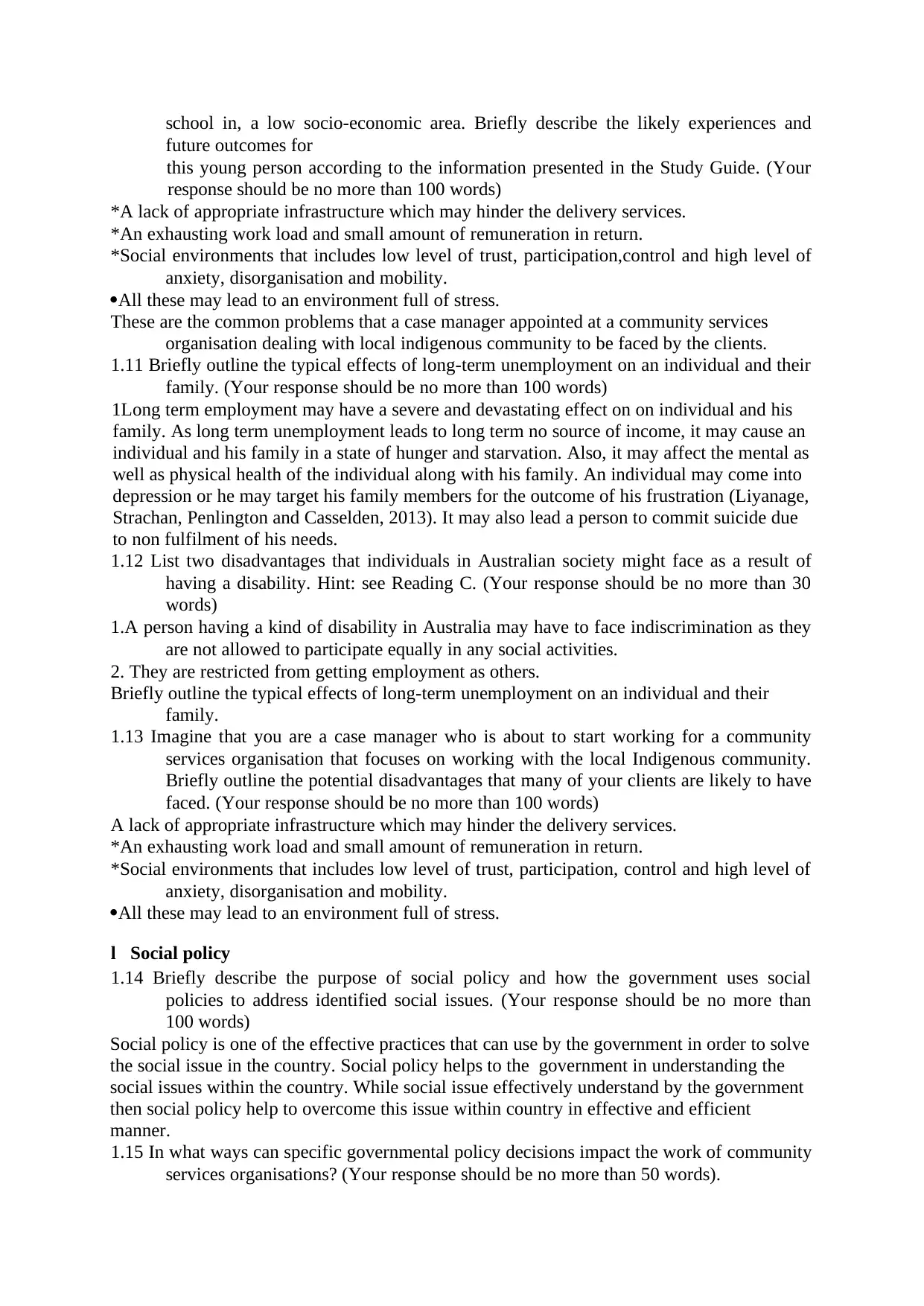
school in, a low socio-economic area. Briefly describe the likely experiences and
future outcomes for
this young person according to the information presented in the Study Guide. (Your
response should be no more than 100 words)
*A lack of appropriate infrastructure which may hinder the delivery services.
*An exhausting work load and small amount of remuneration in return.
*Social environments that includes low level of trust, participation,control and high level of
anxiety, disorganisation and mobility.
·All these may lead to an environment full of stress.
These are the common problems that a case manager appointed at a community services
organisation dealing with local indigenous community to be faced by the clients.
1.11 Briefly outline the typical effects of long-term unemployment on an individual and their
family. (Your response should be no more than 100 words)
1Long term employment may have a severe and devastating effect on on individual and his
family. As long term unemployment leads to long term no source of income, it may cause an
individual and his family in a state of hunger and starvation. Also, it may affect the mental as
well as physical health of the individual along with his family. An individual may come into
depression or he may target his family members for the outcome of his frustration (Liyanage,
Strachan, Penlington and Casselden, 2013). It may also lead a person to commit suicide due
to non fulfilment of his needs.
1.12 List two disadvantages that individuals in Australian society might face as a result of
having a disability. Hint: see Reading C. (Your response should be no more than 30
words)
1.A person having a kind of disability in Australia may have to face indiscrimination as they
are not allowed to participate equally in any social activities.
2. They are restricted from getting employment as others.
Briefly outline the typical effects of long-term unemployment on an individual and their
family.
1.13 Imagine that you are a case manager who is about to start working for a community
services organisation that focuses on working with the local Indigenous community.
Briefly outline the potential disadvantages that many of your clients are likely to have
faced. (Your response should be no more than 100 words)
A lack of appropriate infrastructure which may hinder the delivery services.
*An exhausting work load and small amount of remuneration in return.
*Social environments that includes low level of trust, participation, control and high level of
anxiety, disorganisation and mobility.
·All these may lead to an environment full of stress.
l弐Social policy
1.14 Briefly describe the purpose of social policy and how the government uses social
policies to address identified social issues. (Your response should be no more than
100 words)
Social policy is one of the effective practices that can use by the government in order to solve
the social issue in the country. Social policy helps to the government in understanding the
social issues within the country. While social issue effectively understand by the government
then social policy help to overcome this issue within country in effective and efficient
manner.
1.15 In what ways can specific governmental policy decisions impact the work of community
services organisations? (Your response should be no more than 50 words).
future outcomes for
this young person according to the information presented in the Study Guide. (Your
response should be no more than 100 words)
*A lack of appropriate infrastructure which may hinder the delivery services.
*An exhausting work load and small amount of remuneration in return.
*Social environments that includes low level of trust, participation,control and high level of
anxiety, disorganisation and mobility.
·All these may lead to an environment full of stress.
These are the common problems that a case manager appointed at a community services
organisation dealing with local indigenous community to be faced by the clients.
1.11 Briefly outline the typical effects of long-term unemployment on an individual and their
family. (Your response should be no more than 100 words)
1Long term employment may have a severe and devastating effect on on individual and his
family. As long term unemployment leads to long term no source of income, it may cause an
individual and his family in a state of hunger and starvation. Also, it may affect the mental as
well as physical health of the individual along with his family. An individual may come into
depression or he may target his family members for the outcome of his frustration (Liyanage,
Strachan, Penlington and Casselden, 2013). It may also lead a person to commit suicide due
to non fulfilment of his needs.
1.12 List two disadvantages that individuals in Australian society might face as a result of
having a disability. Hint: see Reading C. (Your response should be no more than 30
words)
1.A person having a kind of disability in Australia may have to face indiscrimination as they
are not allowed to participate equally in any social activities.
2. They are restricted from getting employment as others.
Briefly outline the typical effects of long-term unemployment on an individual and their
family.
1.13 Imagine that you are a case manager who is about to start working for a community
services organisation that focuses on working with the local Indigenous community.
Briefly outline the potential disadvantages that many of your clients are likely to have
faced. (Your response should be no more than 100 words)
A lack of appropriate infrastructure which may hinder the delivery services.
*An exhausting work load and small amount of remuneration in return.
*Social environments that includes low level of trust, participation, control and high level of
anxiety, disorganisation and mobility.
·All these may lead to an environment full of stress.
l弐Social policy
1.14 Briefly describe the purpose of social policy and how the government uses social
policies to address identified social issues. (Your response should be no more than
100 words)
Social policy is one of the effective practices that can use by the government in order to solve
the social issue in the country. Social policy helps to the government in understanding the
social issues within the country. While social issue effectively understand by the government
then social policy help to overcome this issue within country in effective and efficient
manner.
1.15 In what ways can specific governmental policy decisions impact the work of community
services organisations? (Your response should be no more than 50 words).
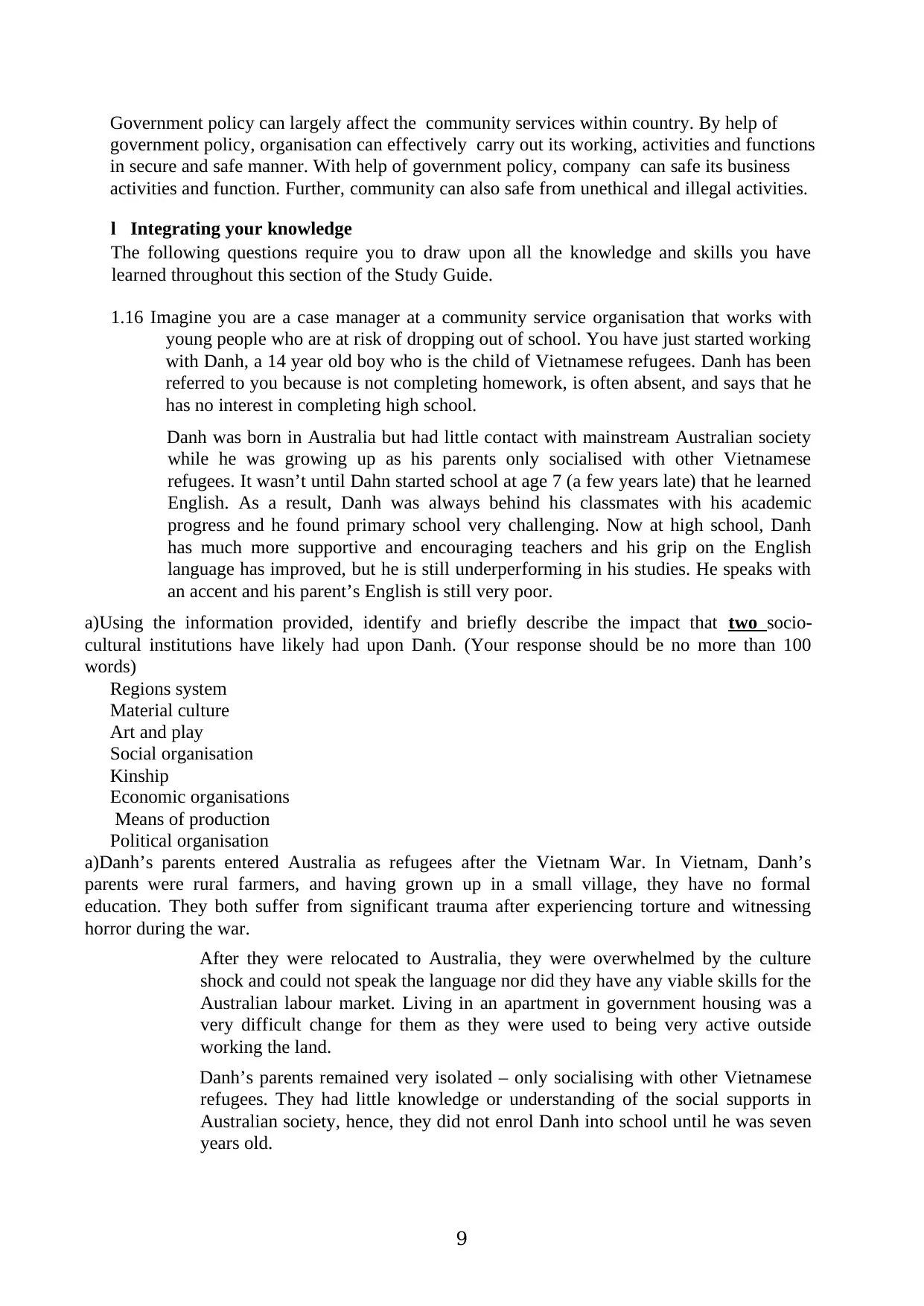
Government policy can largely affect the community services within country. By help of
government policy, organisation can effectively carry out its working, activities and functions
in secure and safe manner. With help of government policy, company can safe its business
activities and function. Further, community can also safe from unethical and illegal activities.
l弐Integrating your knowledge
The following questions require you to draw upon all the knowledge and skills you have
learned throughout this section of the Study Guide.
1.16 Imagine you are a case manager at a community service organisation that works with
young people who are at risk of dropping out of school. You have just started working
with Danh, a 14 year old boy who is the child of Vietnamese refugees. Danh has been
referred to you because is not completing homework, is often absent, and says that he
has no interest in completing high school.
Danh was born in Australia but had little contact with mainstream Australian society
while he was growing up as his parents only socialised with other Vietnamese
refugees. It wasn’t until Dahn started school at age 7 (a few years late) that he learned
English. As a result, Danh was always behind his classmates with his academic
progress and he found primary school very challenging. Now at high school, Danh
has much more supportive and encouraging teachers and his grip on the English
language has improved, but he is still underperforming in his studies. He speaks with
an accent and his parent’s English is still very poor.
a)Using the information provided, identify and briefly describe the impact that two socio-
cultural institutions have likely had upon Danh. (Your response should be no more than 100
words)
Regions system
Material culture
Art and play
Social organisation
Kinship
Economic organisations
Means of production
Political organisation
a)Danh’s parents entered Australia as refugees after the Vietnam War. In Vietnam, Danh’s
parents were rural farmers, and having grown up in a small village, they have no formal
education. They both suffer from significant trauma after experiencing torture and witnessing
horror during the war.
After they were relocated to Australia, they were overwhelmed by the culture
shock and could not speak the language nor did they have any viable skills for the
Australian labour market. Living in an apartment in government housing was a
very difficult change for them as they were used to being very active outside
working the land.
Danh’s parents remained very isolated – only socialising with other Vietnamese
refugees. They had little knowledge or understanding of the social supports in
Australian society, hence, they did not enrol Danh into school until he was seven
years old.
9
government policy, organisation can effectively carry out its working, activities and functions
in secure and safe manner. With help of government policy, company can safe its business
activities and function. Further, community can also safe from unethical and illegal activities.
l弐Integrating your knowledge
The following questions require you to draw upon all the knowledge and skills you have
learned throughout this section of the Study Guide.
1.16 Imagine you are a case manager at a community service organisation that works with
young people who are at risk of dropping out of school. You have just started working
with Danh, a 14 year old boy who is the child of Vietnamese refugees. Danh has been
referred to you because is not completing homework, is often absent, and says that he
has no interest in completing high school.
Danh was born in Australia but had little contact with mainstream Australian society
while he was growing up as his parents only socialised with other Vietnamese
refugees. It wasn’t until Dahn started school at age 7 (a few years late) that he learned
English. As a result, Danh was always behind his classmates with his academic
progress and he found primary school very challenging. Now at high school, Danh
has much more supportive and encouraging teachers and his grip on the English
language has improved, but he is still underperforming in his studies. He speaks with
an accent and his parent’s English is still very poor.
a)Using the information provided, identify and briefly describe the impact that two socio-
cultural institutions have likely had upon Danh. (Your response should be no more than 100
words)
Regions system
Material culture
Art and play
Social organisation
Kinship
Economic organisations
Means of production
Political organisation
a)Danh’s parents entered Australia as refugees after the Vietnam War. In Vietnam, Danh’s
parents were rural farmers, and having grown up in a small village, they have no formal
education. They both suffer from significant trauma after experiencing torture and witnessing
horror during the war.
After they were relocated to Australia, they were overwhelmed by the culture
shock and could not speak the language nor did they have any viable skills for the
Australian labour market. Living in an apartment in government housing was a
very difficult change for them as they were used to being very active outside
working the land.
Danh’s parents remained very isolated – only socialising with other Vietnamese
refugees. They had little knowledge or understanding of the social supports in
Australian society, hence, they did not enrol Danh into school until he was seven
years old.
9
⊘ This is a preview!⊘
Do you want full access?
Subscribe today to unlock all pages.

Trusted by 1+ million students worldwide
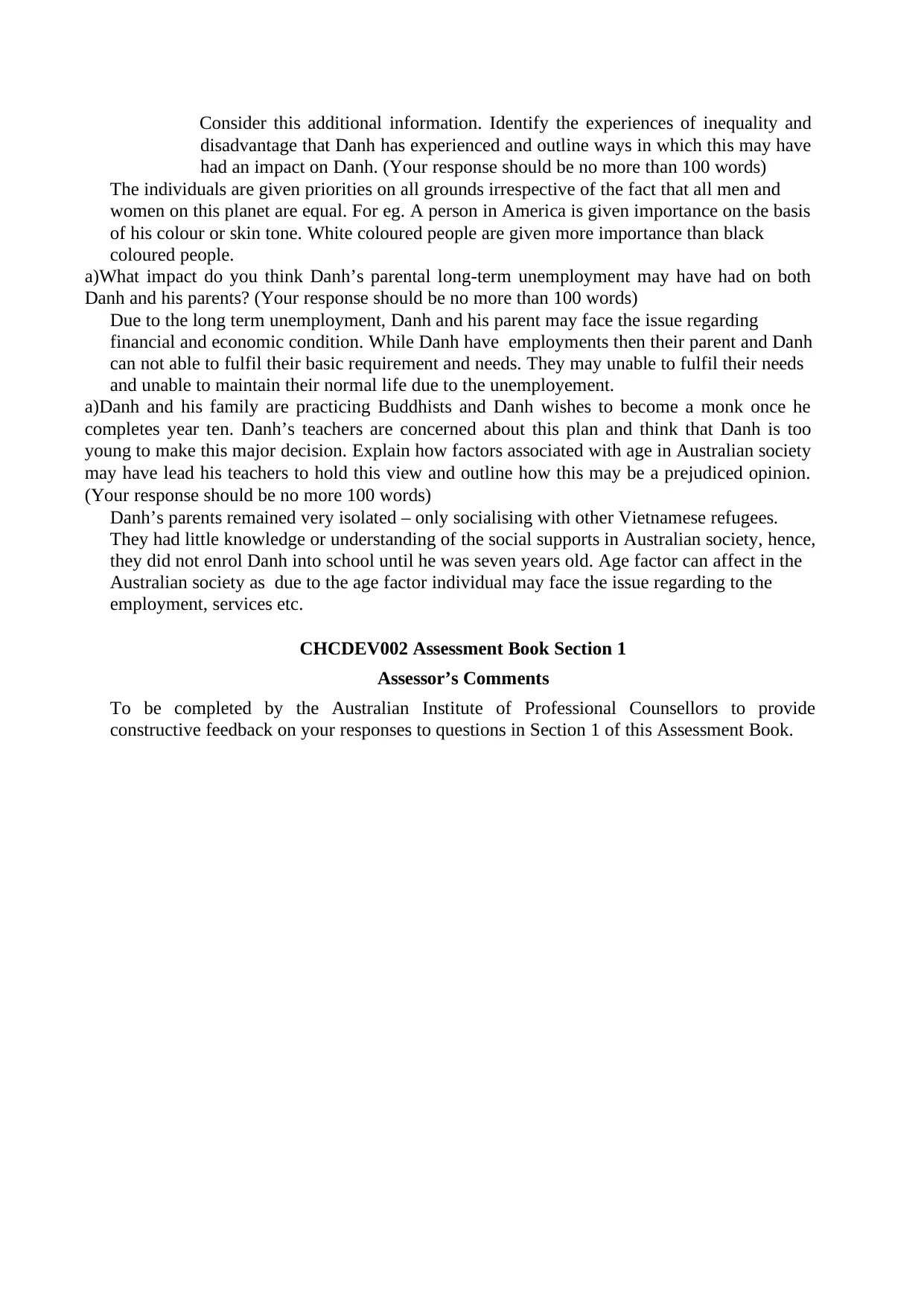
Consider this additional information. Identify the experiences of inequality and
disadvantage that Danh has experienced and outline ways in which this may have
had an impact on Danh. (Your response should be no more than 100 words)
The individuals are given priorities on all grounds irrespective of the fact that all men and
women on this planet are equal. For eg. A person in America is given importance on the basis
of his colour or skin tone. White coloured people are given more importance than black
coloured people.
a)What impact do you think Danh’s parental long-term unemployment may have had on both
Danh and his parents? (Your response should be no more than 100 words)
Due to the long term unemployment, Danh and his parent may face the issue regarding
financial and economic condition. While Danh have employments then their parent and Danh
can not able to fulfil their basic requirement and needs. They may unable to fulfil their needs
and unable to maintain their normal life due to the unemployement.
a)Danh and his family are practicing Buddhists and Danh wishes to become a monk once he
completes year ten. Danh’s teachers are concerned about this plan and think that Danh is too
young to make this major decision. Explain how factors associated with age in Australian society
may have lead his teachers to hold this view and outline how this may be a prejudiced opinion.
(Your response should be no more 100 words)
Danh’s parents remained very isolated – only socialising with other Vietnamese refugees.
They had little knowledge or understanding of the social supports in Australian society, hence,
they did not enrol Danh into school until he was seven years old. Age factor can affect in the
Australian society as due to the age factor individual may face the issue regarding to the
employment, services etc.
CHCDEV002 Assessment Book Section 1
Assessor’s Comments
To be completed by the Australian Institute of Professional Counsellors to provide
constructive feedback on your responses to questions in Section 1 of this Assessment Book.
disadvantage that Danh has experienced and outline ways in which this may have
had an impact on Danh. (Your response should be no more than 100 words)
The individuals are given priorities on all grounds irrespective of the fact that all men and
women on this planet are equal. For eg. A person in America is given importance on the basis
of his colour or skin tone. White coloured people are given more importance than black
coloured people.
a)What impact do you think Danh’s parental long-term unemployment may have had on both
Danh and his parents? (Your response should be no more than 100 words)
Due to the long term unemployment, Danh and his parent may face the issue regarding
financial and economic condition. While Danh have employments then their parent and Danh
can not able to fulfil their basic requirement and needs. They may unable to fulfil their needs
and unable to maintain their normal life due to the unemployement.
a)Danh and his family are practicing Buddhists and Danh wishes to become a monk once he
completes year ten. Danh’s teachers are concerned about this plan and think that Danh is too
young to make this major decision. Explain how factors associated with age in Australian society
may have lead his teachers to hold this view and outline how this may be a prejudiced opinion.
(Your response should be no more 100 words)
Danh’s parents remained very isolated – only socialising with other Vietnamese refugees.
They had little knowledge or understanding of the social supports in Australian society, hence,
they did not enrol Danh into school until he was seven years old. Age factor can affect in the
Australian society as due to the age factor individual may face the issue regarding to the
employment, services etc.
CHCDEV002 Assessment Book Section 1
Assessor’s Comments
To be completed by the Australian Institute of Professional Counsellors to provide
constructive feedback on your responses to questions in Section 1 of this Assessment Book.
Paraphrase This Document
Need a fresh take? Get an instant paraphrase of this document with our AI Paraphraser
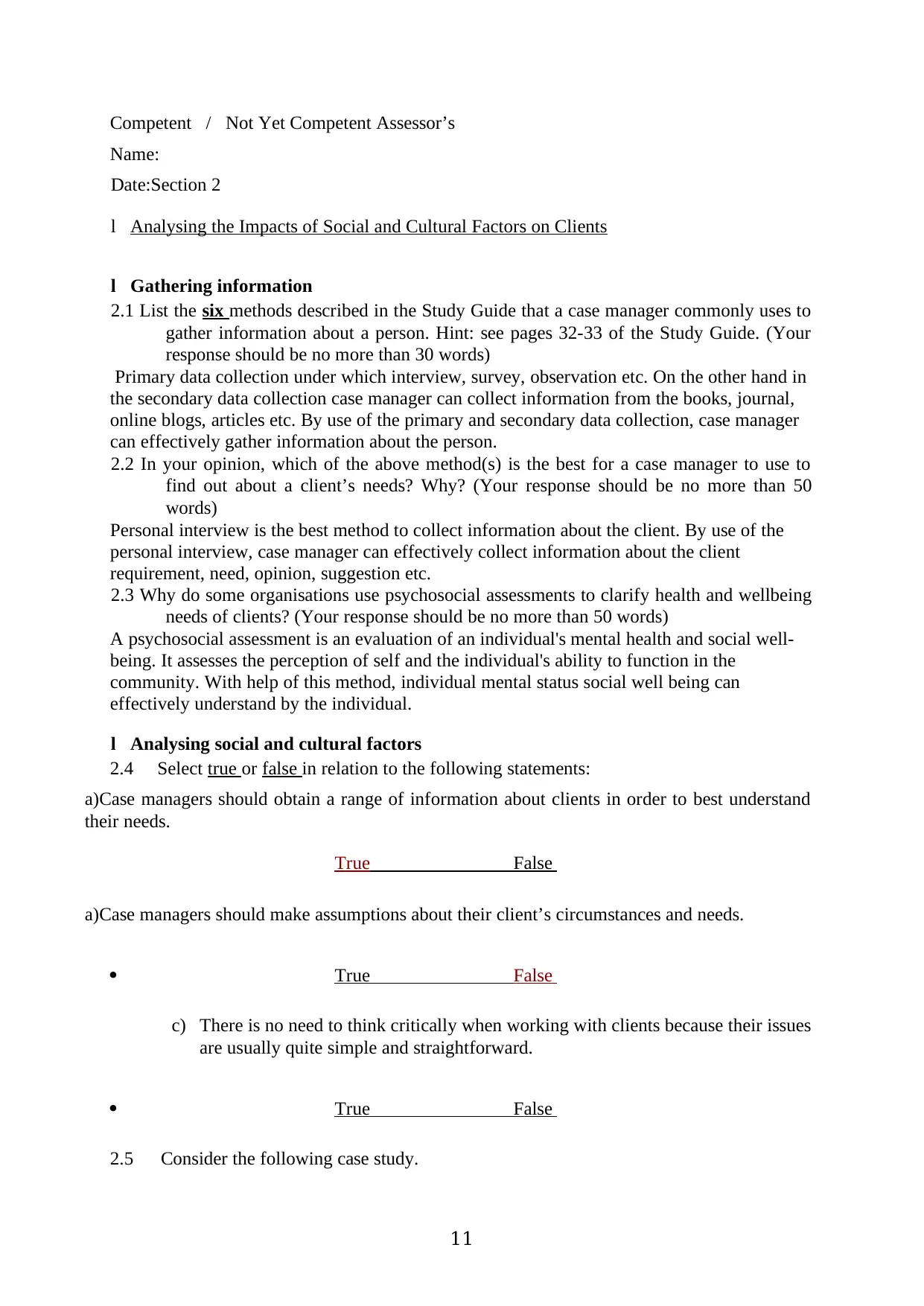
Competent / Not Yet Competent Assessor’s
Name:
Date:Section 2
l壱Analysing the Impacts of Social and Cultural Factors on Clients
l弐Gathering information
2.1 List the six methods described in the Study Guide that a case manager commonly uses to
gather information about a person. Hint: see pages 32-33 of the Study Guide. (Your
response should be no more than 30 words)
Primary data collection under which interview, survey, observation etc. On the other hand in
the secondary data collection case manager can collect information from the books, journal,
online blogs, articles etc. By use of the primary and secondary data collection, case manager
can effectively gather information about the person.
2.2 In your opinion, which of the above method(s) is the best for a case manager to use to
find out about a client’s needs? Why? (Your response should be no more than 50
words)
Personal interview is the best method to collect information about the client. By use of the
personal interview, case manager can effectively collect information about the client
requirement, need, opinion, suggestion etc.
2.3 Why do some organisations use psychosocial assessments to clarify health and wellbeing
needs of clients? (Your response should be no more than 50 words)
A psychosocial assessment is an evaluation of an individual's mental health and social well-
being. It assesses the perception of self and the individual's ability to function in the
community. With help of this method, individual mental status social well being can
effectively understand by the individual.
l弐Analysing social and cultural factors
2.4 Select true or false in relation to the following statements:
a)Case managers should obtain a range of information about clients in order to best understand
their needs.
True False
a)Case managers should make assumptions about their client’s circumstances and needs.
· True False
c) There is no need to think critically when working with clients because their issues
are usually quite simple and straightforward.
· True False
2.5 Consider the following case study.
11
Name:
Date:Section 2
l壱Analysing the Impacts of Social and Cultural Factors on Clients
l弐Gathering information
2.1 List the six methods described in the Study Guide that a case manager commonly uses to
gather information about a person. Hint: see pages 32-33 of the Study Guide. (Your
response should be no more than 30 words)
Primary data collection under which interview, survey, observation etc. On the other hand in
the secondary data collection case manager can collect information from the books, journal,
online blogs, articles etc. By use of the primary and secondary data collection, case manager
can effectively gather information about the person.
2.2 In your opinion, which of the above method(s) is the best for a case manager to use to
find out about a client’s needs? Why? (Your response should be no more than 50
words)
Personal interview is the best method to collect information about the client. By use of the
personal interview, case manager can effectively collect information about the client
requirement, need, opinion, suggestion etc.
2.3 Why do some organisations use psychosocial assessments to clarify health and wellbeing
needs of clients? (Your response should be no more than 50 words)
A psychosocial assessment is an evaluation of an individual's mental health and social well-
being. It assesses the perception of self and the individual's ability to function in the
community. With help of this method, individual mental status social well being can
effectively understand by the individual.
l弐Analysing social and cultural factors
2.4 Select true or false in relation to the following statements:
a)Case managers should obtain a range of information about clients in order to best understand
their needs.
True False
a)Case managers should make assumptions about their client’s circumstances and needs.
· True False
c) There is no need to think critically when working with clients because their issues
are usually quite simple and straightforward.
· True False
2.5 Consider the following case study.
11
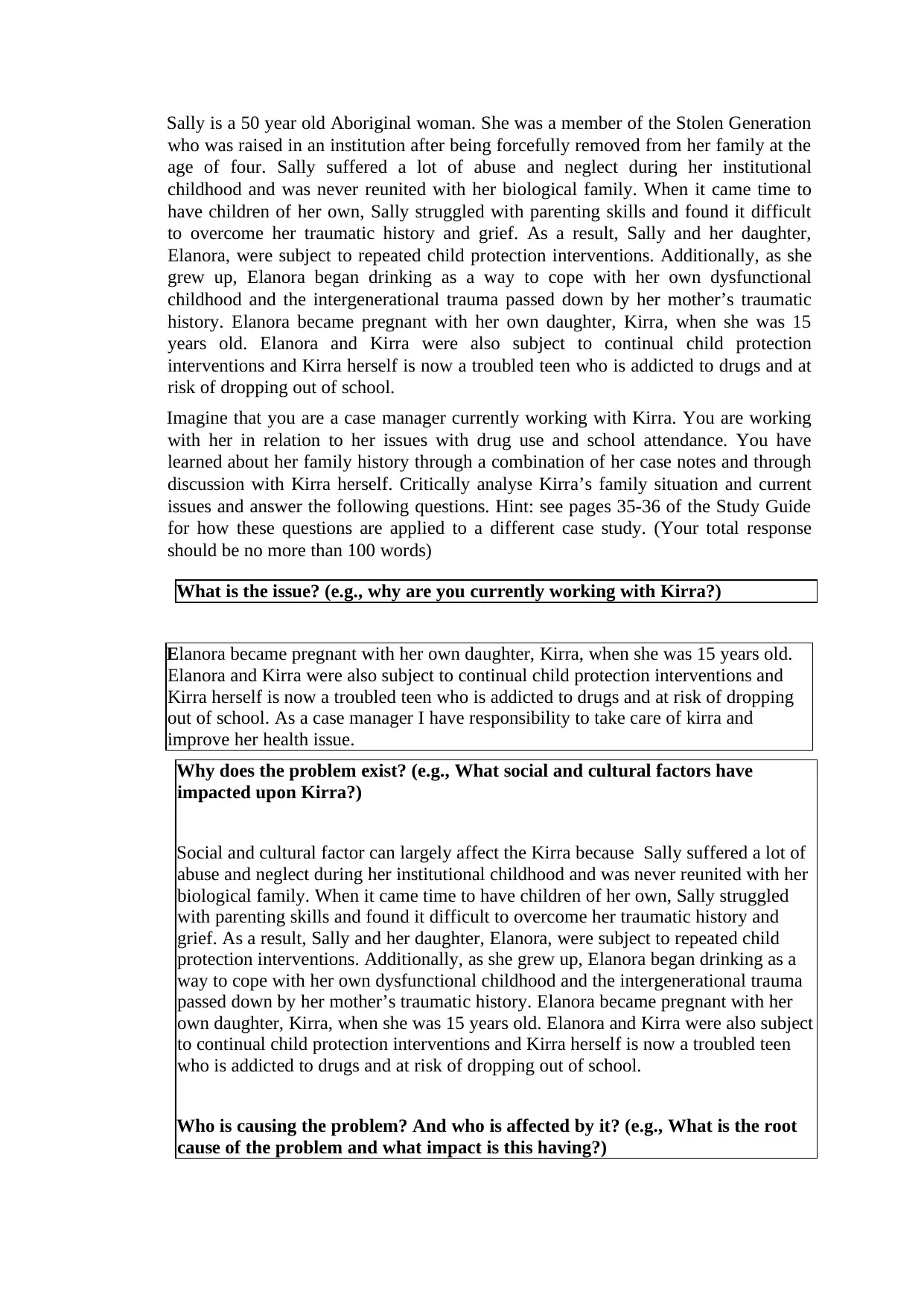
Sally is a 50 year old Aboriginal woman. She was a member of the Stolen Generation
who was raised in an institution after being forcefully removed from her family at the
age of four. Sally suffered a lot of abuse and neglect during her institutional
childhood and was never reunited with her biological family. When it came time to
have children of her own, Sally struggled with parenting skills and found it difficult
to overcome her traumatic history and grief. As a result, Sally and her daughter,
Elanora, were subject to repeated child protection interventions. Additionally, as she
grew up, Elanora began drinking as a way to cope with her own dysfunctional
childhood and the intergenerational trauma passed down by her mother’s traumatic
history. Elanora became pregnant with her own daughter, Kirra, when she was 15
years old. Elanora and Kirra were also subject to continual child protection
interventions and Kirra herself is now a troubled teen who is addicted to drugs and at
risk of dropping out of school.
Imagine that you are a case manager currently working with Kirra. You are working
with her in relation to her issues with drug use and school attendance. You have
learned about her family history through a combination of her case notes and through
discussion with Kirra herself. Critically analyse Kirra’s family situation and current
issues and answer the following questions. Hint: see pages 35-36 of the Study Guide
for how these questions are applied to a different case study. (Your total response
should be no more than 100 words)
What is the issue? (e.g., why are you currently working with Kirra?)
Elanora became pregnant with her own daughter, Kirra, when she was 15 years old.
Elanora and Kirra were also subject to continual child protection interventions and
Kirra herself is now a troubled teen who is addicted to drugs and at risk of dropping
out of school. As a case manager I have responsibility to take care of kirra and
improve her health issue.
Why does the problem exist? (e.g., What social and cultural factors have
impacted upon Kirra?)
Social and cultural factor can largely affect the Kirra because Sally suffered a lot of
abuse and neglect during her institutional childhood and was never reunited with her
biological family. When it came time to have children of her own, Sally struggled
with parenting skills and found it difficult to overcome her traumatic history and
grief. As a result, Sally and her daughter, Elanora, were subject to repeated child
protection interventions. Additionally, as she grew up, Elanora began drinking as a
way to cope with her own dysfunctional childhood and the intergenerational trauma
passed down by her mother’s traumatic history. Elanora became pregnant with her
own daughter, Kirra, when she was 15 years old. Elanora and Kirra were also subject
to continual child protection interventions and Kirra herself is now a troubled teen
who is addicted to drugs and at risk of dropping out of school.
Who is causing the problem? And who is affected by it? (e.g., What is the root
cause of the problem and what impact is this having?)
who was raised in an institution after being forcefully removed from her family at the
age of four. Sally suffered a lot of abuse and neglect during her institutional
childhood and was never reunited with her biological family. When it came time to
have children of her own, Sally struggled with parenting skills and found it difficult
to overcome her traumatic history and grief. As a result, Sally and her daughter,
Elanora, were subject to repeated child protection interventions. Additionally, as she
grew up, Elanora began drinking as a way to cope with her own dysfunctional
childhood and the intergenerational trauma passed down by her mother’s traumatic
history. Elanora became pregnant with her own daughter, Kirra, when she was 15
years old. Elanora and Kirra were also subject to continual child protection
interventions and Kirra herself is now a troubled teen who is addicted to drugs and at
risk of dropping out of school.
Imagine that you are a case manager currently working with Kirra. You are working
with her in relation to her issues with drug use and school attendance. You have
learned about her family history through a combination of her case notes and through
discussion with Kirra herself. Critically analyse Kirra’s family situation and current
issues and answer the following questions. Hint: see pages 35-36 of the Study Guide
for how these questions are applied to a different case study. (Your total response
should be no more than 100 words)
What is the issue? (e.g., why are you currently working with Kirra?)
Elanora became pregnant with her own daughter, Kirra, when she was 15 years old.
Elanora and Kirra were also subject to continual child protection interventions and
Kirra herself is now a troubled teen who is addicted to drugs and at risk of dropping
out of school. As a case manager I have responsibility to take care of kirra and
improve her health issue.
Why does the problem exist? (e.g., What social and cultural factors have
impacted upon Kirra?)
Social and cultural factor can largely affect the Kirra because Sally suffered a lot of
abuse and neglect during her institutional childhood and was never reunited with her
biological family. When it came time to have children of her own, Sally struggled
with parenting skills and found it difficult to overcome her traumatic history and
grief. As a result, Sally and her daughter, Elanora, were subject to repeated child
protection interventions. Additionally, as she grew up, Elanora began drinking as a
way to cope with her own dysfunctional childhood and the intergenerational trauma
passed down by her mother’s traumatic history. Elanora became pregnant with her
own daughter, Kirra, when she was 15 years old. Elanora and Kirra were also subject
to continual child protection interventions and Kirra herself is now a troubled teen
who is addicted to drugs and at risk of dropping out of school.
Who is causing the problem? And who is affected by it? (e.g., What is the root
cause of the problem and what impact is this having?)
⊘ This is a preview!⊘
Do you want full access?
Subscribe today to unlock all pages.

Trusted by 1+ million students worldwide
1 out of 22
Related Documents
Your All-in-One AI-Powered Toolkit for Academic Success.
+13062052269
info@desklib.com
Available 24*7 on WhatsApp / Email
![[object Object]](/_next/static/media/star-bottom.7253800d.svg)
Unlock your academic potential
Copyright © 2020–2025 A2Z Services. All Rights Reserved. Developed and managed by ZUCOL.





